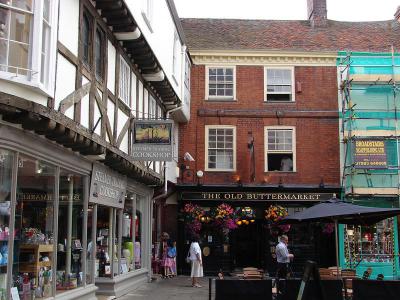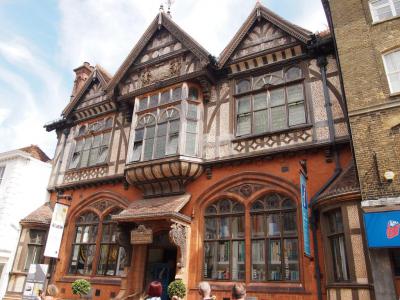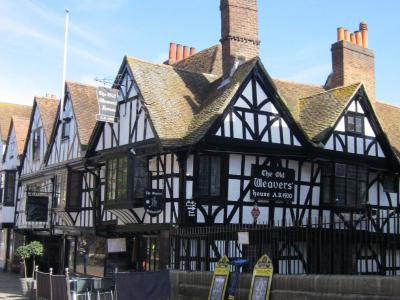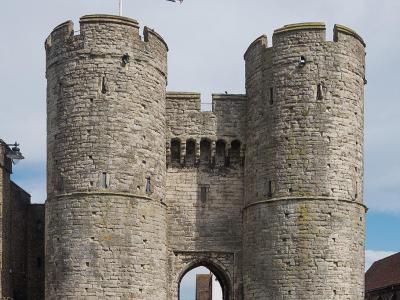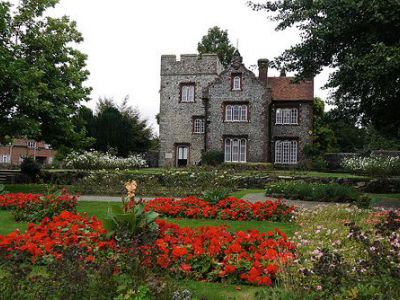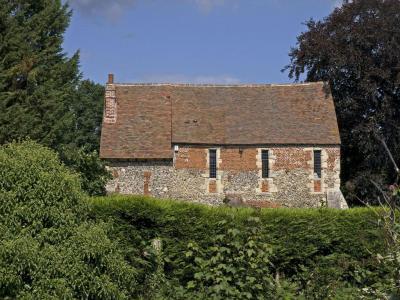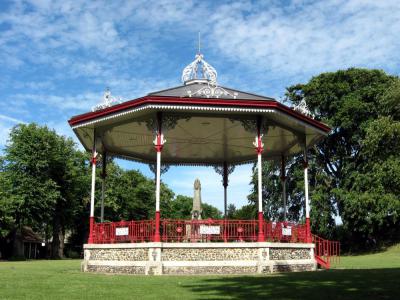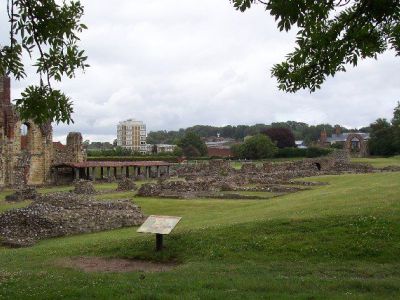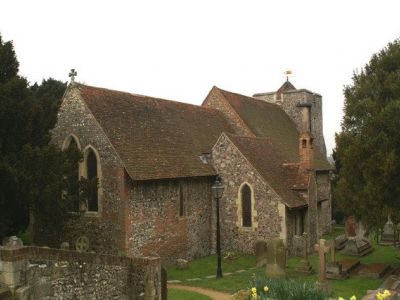
Canterbury Introduction Walking Tour (Self Guided), Canterbury
Canterbury is a UNESCO World Heritage City and one of the most visited cities in England. Canterbury has a long history and has been occupied since Paleolithic times. It was the capital of the Celtic Cantiaci, Romans settled the area for centuries, and the site was the capital of the Kingdom of Kent.
Saint Augustine arrived in Canterbury in 597 to convert the Anglo-Saxons to Christianity. The King of Kent's consort, Queen Bertha, was a Christian, and the King of Kent authorized the Abbey and Cathedral.
Augustine was the first Archbishop of Canterbury, and in 672, the Archbishop of Canterbury was given authority over the entire English church.
In 1170, Archbishop Thomas Becket was murdered by King Henry II's knights. Becket was a strong church leader who was often at odds with the king. The Pope made Becket a saint. His shrine at the Cathedral became a popular pilgrimage site. Pilgrimages to Canterbury were the inspiration for Chaucer's immortal Canterbury Tales book.
A few centuries and a few Henries later, King Henry VIII broke away from the Roman Catholic Church and declared Canterbury Cathedral the leading church of the Church of England during Religious Reformation. Today Canterbury Cathedral is the mother church of Anglicans worldwide.
Canterbury Cathedral is one of the most inspirational and extraordinary churches in England. Saint Augustine founded it in 597, and the cathedral has expanded over the centuries. Its current layout was dedicated in 1077 and is a stunning example of Gothic architecture. Canterbury Cathedral visitors will pass through the ornate Christ Church Gate.
Saint Martin's Church is the oldest church in England that is still used as a church. King Ethelbert of Kent was baptized in Saint Martin's by Saint Augustine. Another important early-Christian site is Saint Augustine's Abbey. Finally, Greyfriars Chapel and the Franciscan Gardens introduce visitors to another piece of England's religious history. The gardens contain some remnants of the friar's original accommodations from the 13th century.
A great place to learn more about Canterbury's fascinating history is the Beaney House of Art and Knowledge. When you're ready to see the sights, slip on your walking shoes and join us on this walking tour of one of England's most fascinating cities.
Saint Augustine arrived in Canterbury in 597 to convert the Anglo-Saxons to Christianity. The King of Kent's consort, Queen Bertha, was a Christian, and the King of Kent authorized the Abbey and Cathedral.
Augustine was the first Archbishop of Canterbury, and in 672, the Archbishop of Canterbury was given authority over the entire English church.
In 1170, Archbishop Thomas Becket was murdered by King Henry II's knights. Becket was a strong church leader who was often at odds with the king. The Pope made Becket a saint. His shrine at the Cathedral became a popular pilgrimage site. Pilgrimages to Canterbury were the inspiration for Chaucer's immortal Canterbury Tales book.
A few centuries and a few Henries later, King Henry VIII broke away from the Roman Catholic Church and declared Canterbury Cathedral the leading church of the Church of England during Religious Reformation. Today Canterbury Cathedral is the mother church of Anglicans worldwide.
Canterbury Cathedral is one of the most inspirational and extraordinary churches in England. Saint Augustine founded it in 597, and the cathedral has expanded over the centuries. Its current layout was dedicated in 1077 and is a stunning example of Gothic architecture. Canterbury Cathedral visitors will pass through the ornate Christ Church Gate.
Saint Martin's Church is the oldest church in England that is still used as a church. King Ethelbert of Kent was baptized in Saint Martin's by Saint Augustine. Another important early-Christian site is Saint Augustine's Abbey. Finally, Greyfriars Chapel and the Franciscan Gardens introduce visitors to another piece of England's religious history. The gardens contain some remnants of the friar's original accommodations from the 13th century.
A great place to learn more about Canterbury's fascinating history is the Beaney House of Art and Knowledge. When you're ready to see the sights, slip on your walking shoes and join us on this walking tour of one of England's most fascinating cities.
How it works: Download the app "GPSmyCity: Walks in 1K+ Cities" from Apple App Store or Google Play Store to your mobile phone or tablet. The app turns your mobile device into a personal tour guide and its built-in GPS navigation functions guide you from one tour stop to next. The app works offline, so no data plan is needed when traveling abroad.
Canterbury Introduction Walking Tour Map
Guide Name: Canterbury Introduction Walking Tour
Guide Location: England » Canterbury (See other walking tours in Canterbury)
Guide Type: Self-guided Walking Tour (Sightseeing)
# of Attractions: 12
Tour Duration: 2 Hour(s)
Travel Distance: 2.7 Km or 1.7 Miles
Author: Sandra
Sight(s) Featured in This Guide:
Guide Location: England » Canterbury (See other walking tours in Canterbury)
Guide Type: Self-guided Walking Tour (Sightseeing)
# of Attractions: 12
Tour Duration: 2 Hour(s)
Travel Distance: 2.7 Km or 1.7 Miles
Author: Sandra
Sight(s) Featured in This Guide:
- Canterbury Cathedral
- Christ Church Gate
- The Old Buttermarket
- Beaney House of Art and Knowledge
- Eastbridge Hospital
- Old Weavers House
- Westgate Tower
- Westgate Gardens and Tower House
- Greyfriars Chapel and the Franciscan Gardens
- Dane John Mount and Gardens
- St. Augustine's Abbey
- St. Martin's Church
1) Canterbury Cathedral (must see)
The formal name of the Canterbury Cathedral is the Cathedral and Metropolitical Church of Christ at Canterbury. It is one of the oldest and most well-known Christian structures in all of England and it is a World Heritage Site.
It was originally founded in 597 and has been expanded and rebuilt many times in its history.
In its earliest days, the church was part of a Benedictine monastic community and was the seat of the archbishop. The first bishop was Augustine of Canterbury, a missionary sent in 596 by Pope Gregory I. He also founded Saint Augustine's Abbey, though it was not called that then, located outside the city walls.
The building as it is now was more or less laid out by Archbishop Lanfranc and dedicated in 1077 after the Norman Conquest. It was built from stone from France and designed to be like the Abbey of Saint-Étienne in Caen.
A pivotal moment in the Cathedral's history was the murder of Archbishop Thomas Becket. Becket was murdered in the northwest transept in 1170 by knights of King Henry II. The events transformed the Cathedral into a place of pilgrimage. Such pilgrims were depicted in Chaucer's Canterbury Tales.
Today the Archbishop of Canterbury serves as the global leader for the Anglican Communion and leader of the Church of England.
Why You Should Visit:
The Cathedral is a World Heritage Site and one of the most stunning examples of Gothic architecture in England.
Tips:
Plan to dedicate at least three hours to tour the Cathedral. GPSmyCity offers a self-guided tour to help you explore the Cathedral and its grounds.
Be sure to look up! Some of the most impressive examples of architecture lie in the fan vaulting, ornate carvings, and beautiful stained glassworks.
It was originally founded in 597 and has been expanded and rebuilt many times in its history.
In its earliest days, the church was part of a Benedictine monastic community and was the seat of the archbishop. The first bishop was Augustine of Canterbury, a missionary sent in 596 by Pope Gregory I. He also founded Saint Augustine's Abbey, though it was not called that then, located outside the city walls.
The building as it is now was more or less laid out by Archbishop Lanfranc and dedicated in 1077 after the Norman Conquest. It was built from stone from France and designed to be like the Abbey of Saint-Étienne in Caen.
A pivotal moment in the Cathedral's history was the murder of Archbishop Thomas Becket. Becket was murdered in the northwest transept in 1170 by knights of King Henry II. The events transformed the Cathedral into a place of pilgrimage. Such pilgrims were depicted in Chaucer's Canterbury Tales.
Today the Archbishop of Canterbury serves as the global leader for the Anglican Communion and leader of the Church of England.
Why You Should Visit:
The Cathedral is a World Heritage Site and one of the most stunning examples of Gothic architecture in England.
Tips:
Plan to dedicate at least three hours to tour the Cathedral. GPSmyCity offers a self-guided tour to help you explore the Cathedral and its grounds.
Be sure to look up! Some of the most impressive examples of architecture lie in the fan vaulting, ornate carvings, and beautiful stained glassworks.
2) Christ Church Gate
The primary route to Canterbury Cathedral passes through the ornate Gothic Christ Church Gate. Entrance to the rest of the Cathedral is through an adjoining guest information center and shop.
Like the rest of the Cathedral, the Gate has been repaired and restored numerous times.
The Gate suffered damage and the main statue was destroyed during the English Civil War in 1643. The statue was not replaced until 1990, even though the rest of the Gate was restored in 1660. In 1803 the original towers were removed but were replaced in 1937.
Over the past few years, there have been ongoing preservation and restoration efforts on the Gate and the rest of the Cathedral.
Like the rest of the Cathedral, the Gate has been repaired and restored numerous times.
The Gate suffered damage and the main statue was destroyed during the English Civil War in 1643. The statue was not replaced until 1990, even though the rest of the Gate was restored in 1660. In 1803 the original towers were removed but were replaced in 1937.
Over the past few years, there have been ongoing preservation and restoration efforts on the Gate and the rest of the Cathedral.
3) The Old Buttermarket
This large pub is situated on Buttermarket Square, which is over 800 years old. It is a very busy place, close to the main entrance of the Cathedral. The Old Buttermarket is a traditional British pub with a modern feel, in a house built upon Roman remains. There are plenty of outdoor tables and indoor seats. They provide an impressive choice of real ales on tap and malt whiskeys, as well as a fine selection of red and white wines. They serve high quality pub food. One of their specials is the Old Buttermarket Steak Pie, that is always a popular choice.
4) Beaney House of Art and Knowledge (must see)
The central museum and library for the city of Canterbury are located in the Beaney Institute building. Admission to the museum and galleries is free, and a trip inside is well worth your time.
The Tudor Revival-style building was designed by city surveyor A.H. Campbell and built-in 1899. It was known as the Beaney Institute until 2012.
The cost of the ornate building was gifted to the Canterbury City Council by Dr. James George Beaney. Beaney was a colorful character in the town's history. He was beset by controversy from the medical establishment.
The museum houses a collection of English and European ceramics and art, along with oriental porcelains. Of course, many items in the collection are of local interest, including the Chair of Saint Augustine and Canterbury pilgrims tokens.
Items on display in the museum span the region's history from prehistoric implements to Roman and Anglo-Saxon antiquities. If you're interested in the Roman period, don't miss the museum's other facility--the Canterbury Roman Museum.
The Tudor Revival-style building was designed by city surveyor A.H. Campbell and built-in 1899. It was known as the Beaney Institute until 2012.
The cost of the ornate building was gifted to the Canterbury City Council by Dr. James George Beaney. Beaney was a colorful character in the town's history. He was beset by controversy from the medical establishment.
The museum houses a collection of English and European ceramics and art, along with oriental porcelains. Of course, many items in the collection are of local interest, including the Chair of Saint Augustine and Canterbury pilgrims tokens.
Items on display in the museum span the region's history from prehistoric implements to Roman and Anglo-Saxon antiquities. If you're interested in the Roman period, don't miss the museum's other facility--the Canterbury Roman Museum.
5) Eastbridge Hospital
Established to give accommodations to the poor pilgrims visiting the shrine of Saint Thomas Becket, the Hospital of Saint Thomas the Martyr of Eastbridge opened around 1190. The facility is now an almshouse for the elderly.
Don't let the word "hospital" lead you astray. This building is not and was never a medical facility. Instead, the word refers to the hospitality it provided to visiting pilgrims.
The buildings of the Hospital are all original and built in the 12th century. There is a Pilgrim's Chapel, whose ceiling shows woodwork and joinery that have been dated to 1285. The Undercroft originally served as a dormitory.
The Refectory was a large open dining space. A 13th-century fresco of Our Lord in Glory is on the wall. It was discovered and conserved in 1879.
As the name may suggest, the building was built on the King's Bridge near the Westgate. The rooms directly over the River Stour were restored in a massive preservation effort from 2014 to 2019.
The eight individual apartments that make up the present-day almshouse are private and not open to the public. The rest of the buildings, however, are. Eastbridge is one of three adjoining sites--the Eastbridge Hospital, Greyfriars Chapel, and The Franciscan Gardens.
Don't let the word "hospital" lead you astray. This building is not and was never a medical facility. Instead, the word refers to the hospitality it provided to visiting pilgrims.
The buildings of the Hospital are all original and built in the 12th century. There is a Pilgrim's Chapel, whose ceiling shows woodwork and joinery that have been dated to 1285. The Undercroft originally served as a dormitory.
The Refectory was a large open dining space. A 13th-century fresco of Our Lord in Glory is on the wall. It was discovered and conserved in 1879.
As the name may suggest, the building was built on the King's Bridge near the Westgate. The rooms directly over the River Stour were restored in a massive preservation effort from 2014 to 2019.
The eight individual apartments that make up the present-day almshouse are private and not open to the public. The rest of the buildings, however, are. Eastbridge is one of three adjoining sites--the Eastbridge Hospital, Greyfriars Chapel, and The Franciscan Gardens.
6) Old Weavers House
Dating from at least the 14th century and reconstructed in the 16th, this must be one of the most photographed historic buildings in Canterbury and one of the top riverside pubs in Kent. Having survived the WWII German bombing campaigns, its timber-framed front can be easily spotted on St. Peter's street, with an even longer front running along the River Stour.
The Old Weavers House takes its name from the hundreds of Huguenots and Walloons who settled in the area after fleeing religious persecution in the 16th/17th centuries in France and the Low Countries. Many had expertise as weavers, and therefore started their trade, requiring well-lit work rooms, in local buildings. Despite having no other true weavers houses that can be seen elsewhere in Canterbury, this building housed a weaving school into the early 1900s.
At the rear is a medieval "ducking stool" that historically served to punish not only scolds (women accused by their husbands of talking back too much!), but also suspected witches, by dunking them into the water. Rather than simply being fixed by the water, however, the stool could be mounted on wheels to allow the convict to be paraded through the streets before punishment was carried out.
For the ultimate riverside experience, the Old Weavers Restaurant has a riverside terrace bursting with plants and flowers to create a restful oasis at the water's edge. Not only that, but diners can also enjoy a 40-minute river tour in one of the punting company owned boats, prior to or followed by a one-course-meal of their choosing.
Mon-Sat: 9am–12am; Sun: 12pm–11:30pm
The Old Weavers House takes its name from the hundreds of Huguenots and Walloons who settled in the area after fleeing religious persecution in the 16th/17th centuries in France and the Low Countries. Many had expertise as weavers, and therefore started their trade, requiring well-lit work rooms, in local buildings. Despite having no other true weavers houses that can be seen elsewhere in Canterbury, this building housed a weaving school into the early 1900s.
At the rear is a medieval "ducking stool" that historically served to punish not only scolds (women accused by their husbands of talking back too much!), but also suspected witches, by dunking them into the water. Rather than simply being fixed by the water, however, the stool could be mounted on wheels to allow the convict to be paraded through the streets before punishment was carried out.
For the ultimate riverside experience, the Old Weavers Restaurant has a riverside terrace bursting with plants and flowers to create a restful oasis at the water's edge. Not only that, but diners can also enjoy a 40-minute river tour in one of the punting company owned boats, prior to or followed by a one-course-meal of their choosing.
Mon-Sat: 9am–12am; Sun: 12pm–11:30pm
7) Westgate Tower
The western gate in the city walls is the 60-foot (18-meter) high Westgate. This impressive structure is the largest surviving medieval gatehouse in England. It was built of local ragstone around 1379 and is the only one of Canterbury's original seven gates still standing.
The Romans built the first city walls in 300 AD. Westgate was always the most crucial entrance, as this was the road from London. The present gate was built to replace the original Roman one.
The building has had various other uses over the years. It was used as the local prison from the 1400s to the 1800s. There was even a cage built in the gateway where select prisoners were allowed to beg from or chat with passers-by.
After the city walls were dismantled in the early 1800s, the jailer's house was built to the north. This building wound up serving as the Canterbury City Police headquarters. It was connected to the jail by an iron bridge. This building is now a bar and cafe.
Presently the structure houses the West Gate Towers Museum and several very realistic and historically-themed escape rooms.
The Romans built the first city walls in 300 AD. Westgate was always the most crucial entrance, as this was the road from London. The present gate was built to replace the original Roman one.
The building has had various other uses over the years. It was used as the local prison from the 1400s to the 1800s. There was even a cage built in the gateway where select prisoners were allowed to beg from or chat with passers-by.
After the city walls were dismantled in the early 1800s, the jailer's house was built to the north. This building wound up serving as the Canterbury City Police headquarters. It was connected to the jail by an iron bridge. This building is now a bar and cafe.
Presently the structure houses the West Gate Towers Museum and several very realistic and historically-themed escape rooms.
8) Westgate Gardens and Tower House (must see)
The Westgate Gardens are an ideal place for a gentle stroll along the river banks and they contain many archaeological remains like vestiges of a Roman wall. It features colorful planting, flower beds, neatly trimmed lawns and a curious oriental plane tree with an enormous trunk said to be one of the largest in Britain. There is a superb old Medieval archway that probably led to St. Augustine's Abbey in the 19th century.
The present Tower House is an early Victorian structure, supposedly built in the middle of the 19th cent., but the exact date is uncertain. It sits at the south end of the Westgate Gardens, a splendid small area along the banks of the River Stour starting at the city’s West Gate. This castle-like house was the residence of Catherine Williamson, Canterbury’s first female mayor from 1939 to 1941. After her death, the house and the 11 acres of surrounding gardens were donated to the city. Today it is the Mayor's administrative headquarters.
The present Tower House is an early Victorian structure, supposedly built in the middle of the 19th cent., but the exact date is uncertain. It sits at the south end of the Westgate Gardens, a splendid small area along the banks of the River Stour starting at the city’s West Gate. This castle-like house was the residence of Catherine Williamson, Canterbury’s first female mayor from 1939 to 1941. After her death, the house and the 11 acres of surrounding gardens were donated to the city. Today it is the Mayor's administrative headquarters.
9) Greyfriars Chapel and the Franciscan Gardens
The Franciscans began arriving in England in 1224, during the lifetime of their founder, Saint Francis of Assisi. Greyfriars was the first friary in England. The name stems from the plain grey cloth and belt ropes that made the friar's habits.
Their original accommodations were poor, and they quickly realized they needed better housing and land to farm. So in 1267, the building was rebuilt from stone.
King Henry VIII's establishment of the Church of England was not good news for the friars. Several brothers were imprisoned, and two were executed for refusing the Act of Supremacy. The friary was disbanded, and the lands and property were surrendered to the Crown.
The land wound up as private property for centuries and was known as the Greyfriars Estate. The precise original site of the friary is unknown. The owners began restoring the one surviving building in 1919. That building had been used as a prison at one point and a guesthouse at another. Today, it is the Greyfriars Chapel, and you can still see the names of inmates carved into the wood walls.
The gardens surrounding the Chapel contain a few other visible elements of the 13th-century buildings, including remnants of the church and part of a stone bridge.
Today the Chapel and Gardens are owned by the Eastbridge Hospital. The gardens and buildings are a quiet and beautiful place to visit and a welcome break from the bustling city.
Their original accommodations were poor, and they quickly realized they needed better housing and land to farm. So in 1267, the building was rebuilt from stone.
King Henry VIII's establishment of the Church of England was not good news for the friars. Several brothers were imprisoned, and two were executed for refusing the Act of Supremacy. The friary was disbanded, and the lands and property were surrendered to the Crown.
The land wound up as private property for centuries and was known as the Greyfriars Estate. The precise original site of the friary is unknown. The owners began restoring the one surviving building in 1919. That building had been used as a prison at one point and a guesthouse at another. Today, it is the Greyfriars Chapel, and you can still see the names of inmates carved into the wood walls.
The gardens surrounding the Chapel contain a few other visible elements of the 13th-century buildings, including remnants of the church and part of a stone bridge.
Today the Chapel and Gardens are owned by the Eastbridge Hospital. The gardens and buildings are a quiet and beautiful place to visit and a welcome break from the bustling city.
10) Dane John Mount and Gardens
The Dane John mound dates from Roman times. It was a burial mound built between the first and fourth centuries. The site was later used as an 11th-century motte-and-bailey castle. This area has been a civic park since 1790.
In 1066, William the Conqueror wanted a castle built for the city. So the Dane John mound was incorporated, as was the circuit of defense.
A motte-and-bailey castle is a simple earthen and timber structure that unskilled laborers can quickly build. It is identified by a raised area of ground, or "motte," a walled courtyard, or "bailey," and a protective ditch and palisade. This structure was later abandoned in favor of the more modern Canterbury Castle, built just north of here in 1123.
The gardens were uniquely designed to feature the history of the site. The castle motte is still prominent, as are the Roman bank and medieval walkways. During World War II, parts of the Gardens were used as an ammunition depot.
The Gardens are the site of the local annual Christmas market and many other festivals throughout the year.
In 1066, William the Conqueror wanted a castle built for the city. So the Dane John mound was incorporated, as was the circuit of defense.
A motte-and-bailey castle is a simple earthen and timber structure that unskilled laborers can quickly build. It is identified by a raised area of ground, or "motte," a walled courtyard, or "bailey," and a protective ditch and palisade. This structure was later abandoned in favor of the more modern Canterbury Castle, built just north of here in 1123.
The gardens were uniquely designed to feature the history of the site. The castle motte is still prominent, as are the Roman bank and medieval walkways. During World War II, parts of the Gardens were used as an ammunition depot.
The Gardens are the site of the local annual Christmas market and many other festivals throughout the year.
11) St. Augustine's Abbey (must see)
Saint Augustine arrived in England in 597. Pope Gregory I sent Saint Augustine to convert the Anglo-Saxons to Christianity. The King of Kent, Ethelbert, was married to Queen Bertha, who was already a Christian. King Ethelbert ordered the construction of a splendid church, and construction on Saint Augustine's Abbey began in 598. At that time, the Abbey was dedicated to Saints Peter and Paul.
While most structures in the area were quickly built with wood building materials, Saint Augustine wanted to build a church with stone to emulate the churches of Rome. Thus, Saint Augustine's Abbey became the main religious building in Kent. In addition, Saint Augustine's Abbey became known as a missionary school where learning and knowledge were celebrated.
Saint Augustine became the first Archbishop of Canterbury and was buried in Saint Augustine's Abbey.
In 978, Dunstan, the Archbishop of Canterbury, renovated and expanded the Abbey. Finally, he re-dedicated the Abbey to Saint Augustine, and the church became known as Saint Augustine's Abbey.
The Abbey gatehouse was rebuilt in 1309 and became known as Fyndon Gate. The chamber in the gatehouse was used as the state bed-chamber, and royalty stayed there on their travels. For example, King Charles I and Queen Henrietta Maria stayed here after their Canterbury Cathedral wedding in 1625. In 1660, Charles II and the Dukes of York and Gloucester stayed here.
Freedom Gate faces Lady Wootton's Green. This small square houses statues of King Ethelberht and Queen Bertha.
King Herny VIII dismantled England's monasteries to make way for the new Church of England. In 1538, Saint Augustine's Abbey became the property of the Crown after 940 years of existing as a monastery. Some of the Abbey was initially used as a residence by royal family members. Throughout the centuries, the Abbey was dismantled.
In 1844, Alexander James Beresford Hope bought the ruins and remaining buildings and began to preserve them. Unfortunately, the site was heavily damaged by World War II bombs.
Saint Augustine's Missionary College survived and is currently used by the King's School, Canterbury.
Why You Should Visit:
Saint Augustine's Abbey is part of the Canterbury World Heritage Site, along with the cathedral and Saint Martin's Church. Visitors can see the ruins of Saint Augustine's Abbey, as well as several important graves. Saint Augustine, Ethelberht of Kent, and early Archbishops of Canterbury are buried on the site.
Tips:
Visit the small on-site museum to get an idea of what the Abbey looked like 1,000 years ago. The museum also has audio tours of the ruins available.
While most structures in the area were quickly built with wood building materials, Saint Augustine wanted to build a church with stone to emulate the churches of Rome. Thus, Saint Augustine's Abbey became the main religious building in Kent. In addition, Saint Augustine's Abbey became known as a missionary school where learning and knowledge were celebrated.
Saint Augustine became the first Archbishop of Canterbury and was buried in Saint Augustine's Abbey.
In 978, Dunstan, the Archbishop of Canterbury, renovated and expanded the Abbey. Finally, he re-dedicated the Abbey to Saint Augustine, and the church became known as Saint Augustine's Abbey.
The Abbey gatehouse was rebuilt in 1309 and became known as Fyndon Gate. The chamber in the gatehouse was used as the state bed-chamber, and royalty stayed there on their travels. For example, King Charles I and Queen Henrietta Maria stayed here after their Canterbury Cathedral wedding in 1625. In 1660, Charles II and the Dukes of York and Gloucester stayed here.
Freedom Gate faces Lady Wootton's Green. This small square houses statues of King Ethelberht and Queen Bertha.
King Herny VIII dismantled England's monasteries to make way for the new Church of England. In 1538, Saint Augustine's Abbey became the property of the Crown after 940 years of existing as a monastery. Some of the Abbey was initially used as a residence by royal family members. Throughout the centuries, the Abbey was dismantled.
In 1844, Alexander James Beresford Hope bought the ruins and remaining buildings and began to preserve them. Unfortunately, the site was heavily damaged by World War II bombs.
Saint Augustine's Missionary College survived and is currently used by the King's School, Canterbury.
Why You Should Visit:
Saint Augustine's Abbey is part of the Canterbury World Heritage Site, along with the cathedral and Saint Martin's Church. Visitors can see the ruins of Saint Augustine's Abbey, as well as several important graves. Saint Augustine, Ethelberht of Kent, and early Archbishops of Canterbury are buried on the site.
Tips:
Visit the small on-site museum to get an idea of what the Abbey looked like 1,000 years ago. The museum also has audio tours of the ruins available.
12) St. Martin's Church (must see)
Saint Martin's Church is known as England's oldest church still used as a church and the oldest parish church in the English-speaking world. Records indicate the church building originated during the fifth or sixth century.
King Ethelberht and Queen Bertha of Kent renovated this Romano-British building around AD 580. The church was dedicated to Saint Martin of Tours.
Saint Augustine of Canterbury arrived in 597 and expanded the church. Saint Augustine was on a mission to convert the English to Christianity, and he baptized King Ethelberht in Saint Martin's.
Saint Martin's construction includes Roman tiles and reused Roman bricks. In addition, the remains of a Roman tomb were integrated into the building.
The church has been modified over the centuries. The blocked square-headed doorway in the chancel might have been the entrance to the church during Queen Bertha's time. Parts of the church wall, including the nave, were built in the seventh or eighth century. The tower was built in the 14th century in the English Gothic style.
Why You Should Visit:
Saint Martin's has been a place for Christians to gather since the sixth century. It was here that Saint Augustine first arrived to spread the message of Christianity.
Tips:
Don't miss visiting the church graveyard. Well-known gravesites include artist Thomas Sidney Cooper and writer Mary Tourtel, Rupert Bear's creator.
King Ethelberht and Queen Bertha of Kent renovated this Romano-British building around AD 580. The church was dedicated to Saint Martin of Tours.
Saint Augustine of Canterbury arrived in 597 and expanded the church. Saint Augustine was on a mission to convert the English to Christianity, and he baptized King Ethelberht in Saint Martin's.
Saint Martin's construction includes Roman tiles and reused Roman bricks. In addition, the remains of a Roman tomb were integrated into the building.
The church has been modified over the centuries. The blocked square-headed doorway in the chancel might have been the entrance to the church during Queen Bertha's time. Parts of the church wall, including the nave, were built in the seventh or eighth century. The tower was built in the 14th century in the English Gothic style.
Why You Should Visit:
Saint Martin's has been a place for Christians to gather since the sixth century. It was here that Saint Augustine first arrived to spread the message of Christianity.
Tips:
Don't miss visiting the church graveyard. Well-known gravesites include artist Thomas Sidney Cooper and writer Mary Tourtel, Rupert Bear's creator.
Walking Tours in Canterbury, England
Create Your Own Walk in Canterbury
Creating your own self-guided walk in Canterbury is easy and fun. Choose the city attractions that you want to see and a walk route map will be created just for you. You can even set your hotel as the start point of the walk.
Canterbury Cathedral and Grounds
Canterbury Cathedral, one of the oldest churches that played a crucial role in English Christianity, stands within its own walled area, surrounded by Medieval buildings and ruins.
At the heart of this ensemble rises the cathedral itself, a magnificent example of medieval architecture and a UNESCO World Heritage Site. As you enter, you'll pass through the imposing Christ Church Gate, a... view more
Tour Duration: 1 Hour(s)
Travel Distance: 0.8 Km or 0.5 Miles
At the heart of this ensemble rises the cathedral itself, a magnificent example of medieval architecture and a UNESCO World Heritage Site. As you enter, you'll pass through the imposing Christ Church Gate, a... view more
Tour Duration: 1 Hour(s)
Travel Distance: 0.8 Km or 0.5 Miles
The Most Popular Cities
/ view all


